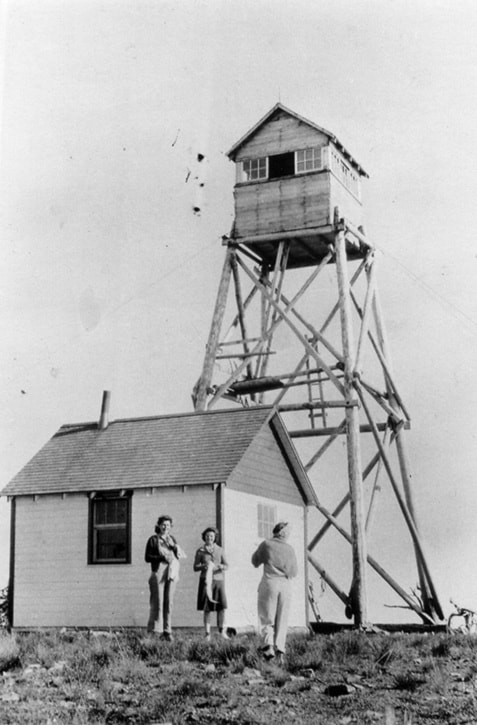Many people in this valley have never been on Mount Thompson’s top. Some don’t even know there is an old fire lookout on the peak. Even some that were born in the valley have never made the trip. The present lookout has been a landmark since the late 1950s and the top has had a lookout landmark since the early 1930s.
The first “official” access to the fire lookout location was probably by an early 1930s pack trail that is still evident on the lower part of the mountain as a hiking trail. The upper route of the trail was likely obliterated by construction of the road that is now the Mount Thompson Forest Service Road. The lower part of the pack trail is a fine exhibition of good engineering as it contours through the gullies and around the steep shoulders of the mountain slopes. The grade was eased by a number of switchbacks, which made it suitable for pack animals carrying supplies to the fire lookout. This trail may have been the main access to the fire lookout until the late 1940s when a road, now deactivated, was constructed on the south side of Sullivan Creek.
The lookout crew, usually only one person, used the trail along with many local people who went up to pick huckleberries and who sometimes continued on to visit the fire lookout and whoever was keeping a watch for smoke. Of course, the lookout person would be somewhere else when the fire danger was low.
The first lookout shelter was likely a canvas tent. A later structure appears to be a six foot-by-six foot “cabin” mounted on four 40- or 50-foot poles, braced by more poles and accessed by several rickety pole ladders that led to a hatch in the floor. The present lookout, when it was in use, was much more elaborate, being furnished with several wood chairs, a cot, pots and pans, dishes, a gas stove, a table and a sink, and, of course, personal belongings and tools of the trade. Some of these would be binoculars, a fire finder, maps and even fire fighting equipment.
Additions to the structure would be lightning rods and cables, plus a list of instructions in case of an approaching lightning storm. Exit the top of the mountain or go down in the bottom level of the lookout, get down low, stay dry, sit with legs pulled up in wood chairs with glass insulators on the legs and stay away from metal objects would be some of the instructions of a list of, say, 15 items.
In the days when only the trail went to the lookout, people everywhere did a lot more walking. On Mount Thompson, hikers would hike right from the bottom up the trail to the lookout. A few people do that now and some access the Thompson Range from ravines farther south. From the present top and fire lookout, the Rim Trail leads along the crest to the south over several humps of the range to a high point where one can behold another excellent view of the Kootenay River valley, Duck and Kootenay lakes, and the surrounding mountains.
Today Mount Thompson and the old lookout are commonly accessed in summer by a high clearance four-wheel-drive vehicle over a rough forest service road and, in winter, by snowmobile or on foot. A visit to the top of Thompson is a great way to gain a new appreciation of this sea of mountains and valleys. On clear days, one can spot Hulme Peak, Haystack Mountain and even Fisher Peak near Cranbrook.
Occasionally, one can get a wildlife “tour” up there. One visitor saw a movement in the doorway to the lower part of the lookout. On approaching the door, a mountain goat exited and headed away over the mountain. Inside it must have found the old mattress a cozy resting spot. So it is still in use by “some”.
The old, but solid, fire lookout is not destined to be around much longer. While other lookouts, with strong community support, have been refurbished or are going to be refurbished, the Mount Thompson lookout is slated to be removed (destroyed) in the spring, unless a local group or organization who is willing to take it over comes forward. Up to now it has been a primitive emergency shelter, of historical interest, and a focal point for many hikers and visitors to the valley.
If you know more about this lookout spot and/or Mount Thompson, give a holler!
Ed McMackin is a biologist by profession but a naturalist and hiker by nature. He can be reached at 250-866-5747.
